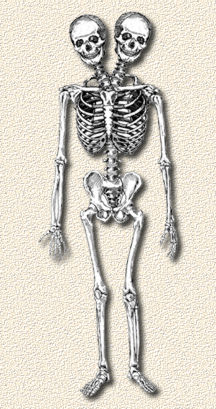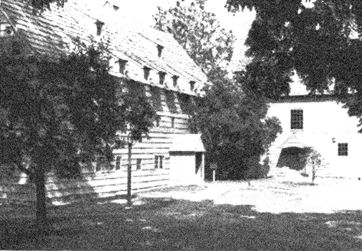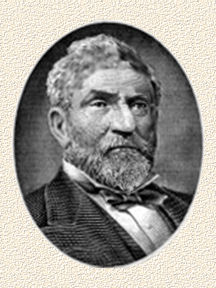Origin Of Two-Headed Giant Revealed
 Delaware: Despite the passage of nine months of investigation and testing, the riddles surrounding the skeletal remains of an 11 foot tall two-headed giants continue to gather about it like the skin of an onion. A bulldozer operator discovered the unusual remains on the grounds of the University of Emmetsburg Coffins Grove Observatory Facility in November last year. They soon became a hotly contested debate as to the age and origin of the remains (see: Remains of Giant Two-Headed Man Unearthed, November, 1996, Issue #11). The bones lay some 8 feet below the surface in a layer of soil belonging to the late Cretaceous Era--- over 65 million years ago. Some authorities originally thought that this may have been the age of the remains, however, a series of dating tests by the U of E Center for Archeological Research indicates that the bizarre man---or men--- died approximately at the end of the 19th century.
Delaware: Despite the passage of nine months of investigation and testing, the riddles surrounding the skeletal remains of an 11 foot tall two-headed giants continue to gather about it like the skin of an onion. A bulldozer operator discovered the unusual remains on the grounds of the University of Emmetsburg Coffins Grove Observatory Facility in November last year. They soon became a hotly contested debate as to the age and origin of the remains (see: Remains of Giant Two-Headed Man Unearthed, November, 1996, Issue #11). The bones lay some 8 feet below the surface in a layer of soil belonging to the late Cretaceous Era--- over 65 million years ago. Some authorities originally thought that this may have been the age of the remains, however, a series of dating tests by the U of E Center for Archeological Research indicates that the bizarre man---or men--- died approximately at the end of the 19th century.
Pierce Hillus of the U of E Student Extraterrestrial Advisory Team views the date with severe skepticism. "It's a lie! Fossilman and all those guys are part of the conspiracy to cover up the truth that aliens were here during the Age of the Dinosaurs tinkering with the genetics of this planet. I mean, the bones were buried in the ground without any disturbance to the soil at all. That means that no one dug into the ground whenever they say it was, and buried a dead inmate from an asylum. They would have had to break up the ground, right? That's 65 million years of erosion; you just don't dig a hole and put back all the layers in perfect order without leaving an outline of that hole. And what about the statue? Distended head, big eyes: that's an alien image. What more proof do they need? The body they found is a failed human/alien hybrid and the statue is its fetish or idol. Don't let these guys fool you! They're in on it!"
But, U of E Center for Archeological Research Project Director Ernst Fossilman makes a singular astute observation.
"If this man's bones are 65 million years old, why aren't they fossilized? As for the whether or not something disturbed the soil stratigraphy, we have a very good answer to that observation: the ground was disturbed. The body lay in a silt-clay deposit at the bottom of a deep gully running through the Cretacious layer. This gully occurred at the end of a small corn field belonging to the Angel Sanitarium. We don't know why yet, but I'd say someone was attempting to conceal any trace of the body. Erosion from the field filled in the gully, probably when the plowing direction changed. So, it's really only about 80 years of alluvial deposition and not 65 million."
Factual evidence clearly shows Fossilman is the one the right track. Information only recently discovered in the Coffins Grove Historical Society reveals a disturbing and startling picture of circumstances leading to the burial of the two-headed giant.

The Angel Sanitarium as it appeared around 1878 in Coffins Grove. The building on the housed male patients; the structure in the back housed female patients. The area is now occupied by telescope domes belonging to the University of Emmetsburg.
But in 1872, Dr. Knaur suffered a stroke leaving him paralyzed on the left side and confining him to a wheel chair for the rest of his life. His son, Dr. Joseph Knaur took over the Sanitarium and ran it until the state forcibly closed it in 1929. The younger Dr. Knaur had served with distinction in the 4th Iowa Mounted Rifles during the Civil War and later went on to study medicine at the Sarbonne in Paris as well as further research in Berlin and Vienna. During his time in Europe, he impressed many medical scholars of the day. Dr. Thomas H. Huxley, the most renown British natural scientist and physiologist of his day, went so far as to publicly acclaim Knaur as a rising star in the then infant field of genetics. Even Max Ferdinand Sebaldt von Werth employed certain rubrics of Knaur's theories and applied them to his own work. Yet despite his growing reputation, Knaur abandoned Europe to return home to Iowa to administer Angel Sanitarium. His public reasons were because he loved his childhood home and couldn't turn his back on his parents' work or their patients.
Noble sentiments indeed. Yet, within five years of his return, his mother and ailing father had died under highly suspicious circumstances. His mother Angelique fell from a speeding train, and his father shot himself to death, supposedly distraught over his wife's death. Knaur, meanwhile, ran the Sanitarium with both prudence and sound medical expertise until State authorities inexplicably closed it the night of September 21, 1929. The State Board of Health never allowed the reasons made public; though local officials made excuses of an investigation into medical misconduct. Knaur vanished that night, though State Police records state they turned him over to "Federal Authorities".
However, this reporter discovered several boxes of papers in the attic of the Historical Society. In particular were certain private papers, which according to the curators, were turned over to the Society by the University of Emmetsburg when the Knaur house was demolished to make way for the Observatory Facility in 1934. These private papers contained several pages torn from Dr. Joseph Knaur's own journal.

Dr. Joseph Knaur, c. 1898.
Unfortunately, the 17 female patients are all ill suited to provide an ideal mate for Lesser, being mostly too old or disfigured...
But in 1891, a sudden and frightening correspondence is begun with the monstrous Amos Dues (see: Amos Dues' Home For Wayward Girls, vol. 3, Issue #7). Though there exists but one letter from Dues himself, Knaur records in his notes that Dues' was quite enthusiastic about Knaur's ideas and research. It is likely, however, that Knaur was merely reading what he wanted to hear. The sole surviving letter from Dues is terse, indicating his distaste for Knaur's project:
I regret to inform that the course of events has progressed badly. The child is little better than a freakish monster, kept alive by its own sheer will. The mother died delivering it. Offer no condolences, for none mourn her. Her passing proved useful for my own purposes. But this offspring is a monstrous thing I can scarcely bare to endure. The faces have about them an imponderable malevolence, devoid of those nobler properties of loyalty and courage you sought to capture and control. The child snatches and grabs, uttering the vilest of gurgles and snorts, acting more like a demon than infant. Seeing such a creature, I no longer believe in the possiblility for the redemption of the human spirit when it may well carry a horror like this at its core.
I have employed a wench to nurse it, though you must not wonder at my methods, for its sheer hateful nature requires the use of sundry drugs to pacify the nurse, let alone the disgusting creature she tends. It is growing quite rapidly and may in a few short years attain the height of a full adult. At your earliest convenience, remove it to the Sanitarium where you can best decide its fate.
Knaur did come shortly there after return with the monstrous child some two weeks later. The child meanwhile is described vividly in Knaur's notes:
Upon returning with the child, I had him confined in a cell on the up most floor because of its extreme aberrant and violent behavior. All attempts at mollifying what strikes me as a natural inborn rage have failed. At an age of only one month, it lunges, snaps, and attempts to bite having achieved an overall length of three feet and a weight of fifteen pounds. It is only through a hideous and degenerate wet nurse, supplied by Mr. Dues, whose eerie patience and use of a reeking elixir that the child is kept nourished. After prolonged observation that I have discovered that it has been born with a rare form of hypersomatotropism exasperated because the pituitary glands in both heads are afflicted. It is covered by rough coarse hair, has a pungent reek about it, and unnaturally dark skin. I am sorely tried by the urge to shoot it. But, no matter how frustrating the challenge appears, I am resolved to selectively breed out the numerous faults...
Though Dues offered to make new arrangements for breeding Lester, Knaur refused. It is unknown whether their correspondence continued or not. The two headed child, meanwhile, grew at a phenomena rate, attaining a height of six feet by age 4. It was then that its more sinister mental abnormalities manifested themselves. Knaur's entries become more sporadic at this point and make little mention of the child yet refer to numerous injuries sustained by care staff. But recorded in the financial records of the sanitarium is the purchase of a specially constructed steel door. On February 7, 1896, the ledger records a "payment for damages" that corresponds to a concurrent newspaper report of several bulls on a nearby farm being savaged by "an unknown beast of gigantic proportions." A few months later, there is a short entry in Knaur's journal dated September 9, 1896:
The thing is too big and too dangerous. Liability has become too great for such little promise. Best to get rid of it now. Too much time has been wasted maintaining the misbegotten wretch. The debacle with the bulls was too much. I have good evidence it will prove impotent and incapable of being bred. Dissection would prove most illuminating, but I lack both time and facilities. A more promising subject has found its way here and my plans to enlarge the sanitarium should precipitate a suitable number of mates.
According to a medical description of hypersomatotropism, the skeleton develops a barrel chest, necrosis and erosion in the joints as well as other symptoms of arthritis. This may have occurred in concert with a host of other defects such as Marfan's syndrome which produces a tall lankiness in the body. Still other indications show a premature aging disorder such as Hutchingson-Guilford, a form of the genetic disorder Progeria. This might have caused Dr. Fossilman to conclude the chronological age of the body to be 55-60 years old. At any rate, it is likely the remains discovered are in fact the awful work of Dr. Knaur's eugenics experiments. Judging from what has come down to us through his surviving notes, and the forced closing of the sanitarium in 1929, we may find ourselves frantically wishing that Pierce Hillus' errant assertion about extraterrestrials was correct after all.
Back to this Issue Contents
